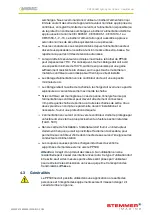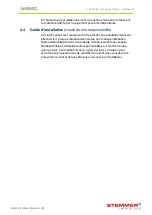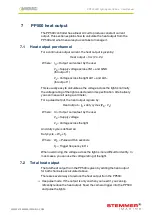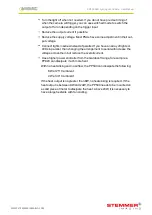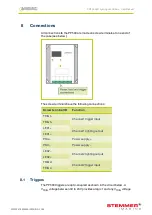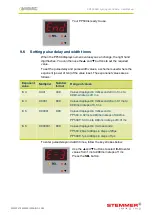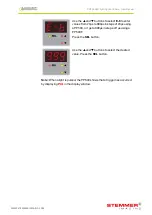
PP500 LED lighting controllers - User Manual
6
Mechanical fixing
The PP500 can be mounted onto a flat surface using the M4 clearance
mounting holes in the corners of the base or the M4 threaded holes in the
centre, see the diagram below.
Note:
If you choose to mount the PP500 using the threaded holes, ensure
no more than 6mm of thread can be screwed in.
The PP500 should only be mounted either vertically or with its base
horizontal. It should be mounted at least 15mm away from the sides of
plastic enclosures. Likewise leave a similar space between the PP500 and
any parts which could be affected by high temperatures.
The enclosure of the PP500 is used to dissipate power in the form of heat.
For this reason the material to which the unit is attached must be suitable,
preferably metallic with ability to dissipate the produced heat. This is
particularly important if the power dissipation of the PP500 (as defined by
P
D
in ) exceeds 8 Watts.
The PP701 kit is available for mounting the PP500 on a DIN rail.
The PP500 does not have an IP rating and should be mounted so that
moisture and dirt cannot enter the unit.
—
16
—
PP500 LED lighting controllers - User Manual
To avoid a fire hazard, consider the implications of overheating in the
unlikely event of a fault in the PP500. The power dissipation in a fault
condition is approximately given by the sum of the following for the two
channels:
(V
PS
-V
L
) x I
PS
Where:
V
PS
= Power supply voltage
V
L
= Rated voltage for lighting
I
PS
= Maximum current delivered by the power supply.
Either limit the power supply output current(s) so that not more than 30W
can be dissipated in the PP500, or mount the unit in an enclosure.
For further information about heat output from the PP500, refer to
Section
7, PP500 heat output
.
To limit the power, set the power supply output voltages to the minimum
value required by the LED light and the PP500 together. Chose a PSU that
limits its output current by design, by setting the current limit on the supply
(if this feature exists) or use fuses. Remember to de-rate the fuse if
mounted in an enclosure, as the temperature will be higher than ambient.
An enclosure may also be required for other parts of the system such as
power supplies and should provide mechanical and environmental
protection in industrial applications.
If an enclosure is used, it should be metal or plastic (with a flammability
rating of UL94-V1 or better) and with no holes below or to the sides of the
PP500 when mounted. Cable entries below the PP500 should be through
glands that also have a flammability rating of UL94-V1 or better. Observe
the specified gap between the PP500 and any other part or side of the
enclosure.
—
17
—
WWW.STEMMER-IMAGING.COM










